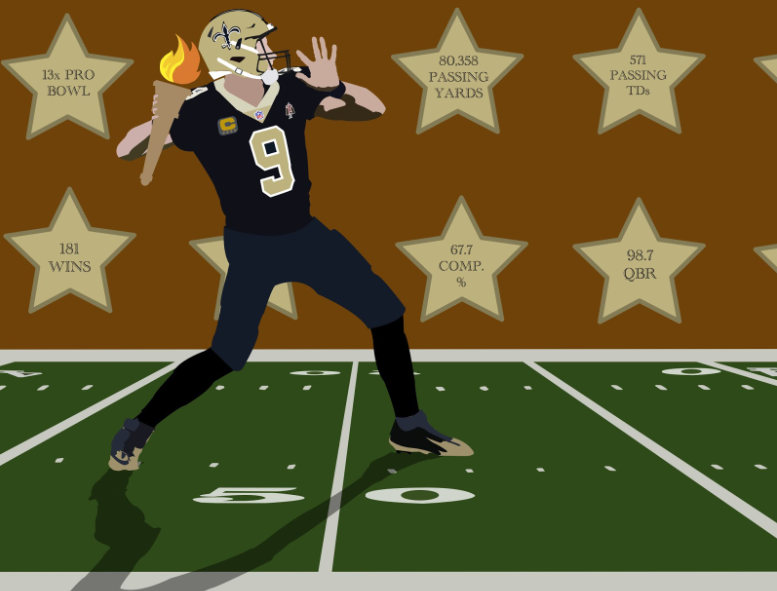Changing of the (Offensive) Guard
In spite of recent retirements, NFL contains new stars carrying legacies of veterans, crafting own paths
On January 17, Drew Brees and Tom Brady embraced at the midfield black fleur-de-lis Saints logo, Brady’s Buccaneers having avenged two regular season losses to Brees’ Saints during the regular season en route to an National Football Conference (NFC) Championship Game — and ultimately a Super Bowl — win. As Brees basked in all that Mercedes-Benz Superdome had offered him — a Super Bowl run of his own, unforgettable comebacks and numerous record-setting moments — fans of the National Football League (NFL) grappled with the idea that Brees would seemingly never play another snap of professional football.
Brees, a former second round pick by the San Diego Chargers, had likely strapped his chinstrap, buckled his pads and laced his cleats for the final time in his storied 20-year career. As he amassed 13 Pro Bowl nominations, the (current) all-time NFL record in passing yards and passes completed and a Walter Payton Man of the Year award, Brees served as an inspiration to adolescents worldwide — including Adam Rosen ’19, host of “The Analytics Association” for the University of Missouri’s KCOU student radio.
“Drew Brees gives me inspiration, for kids especially, because he’s really short for a quarterback (5’11”), and I think most people aren’t going to be 6’0”,” Rosen said. “I think that gives kids a dream like, ‘I want to be that guy.’”
Brees, a likely first-ballot Hall-of-Famer, helped to craft his legacy not just by defying doubters, but also by assisting New Orleans subsequent to the tumult of Hurricane Katrina. For Rosen, what is truly emblematic of Brees’ greatness is his commitment to the metropolis and to the Saints organization.
“Brees got hurt — dislocated his shoulder in San Diego, left, and instead of going to Miami — which was nicer, wasn’t hit by Hurricane Katrina — he decided to go to New Orleans and help rebuild and be a part of the organization,” Rosen said. “I think that’s something admirable just about his character: he wanted to go help fix that city no matter what.”
Brees was widely considered an elder statesman and a “face” of the league during his tenure, a player who rarely failed to amaze or lead his team to victory; in fact, Brees’ 181 wins (postseason included) rank fourth all time.
Yet as Brees and other NFL mainstays, including former quarterbacks Philip Rivers, Peyton Manning and Eli Manning and former tight ends Greg Olsen and Jason Witten, begin to hang up their cleats and venture for Fort Lauderdale, the league has recently witnessed an exodus of whom many consider to be legends.
However, even as former MVPs and Super Bowl winners no longer take the field, their style of play and commitment to excellence continues to inspire younger generations of football players, including Stevenson athletes.
Stevenson Head Football Coach Brent Becker explained that in light of the COVID-19 pandemic, players have scrutinized skills being implemented in all levels of football, especially by high-level talent and NFL icons.
“Our coaches really do an amazing job: they find a clip, and they send it to our kids and they say, ‘Hey, this is what we are looking for you guys to do,’” Becker said. “It doesn’t have to be a big-name star, but I think when kids can see other people using the techniques that we’re teaching them, that just solidifies and emphasizes to them, ‘Hey, what Coach is teaching me is being used elsewhere, and that’s what’s going to help me be the best player I can be.’”
Ultimately, what allowed such NFL standouts to soar up jersey sales rankings and inspire the next generation of All-Pros may be their ability to step up when needed most. In particular, some — including Ricky Wang ’21, an ardent Green Bay Packers fan who first started watching football during the team’s title run in 2010 — feel that the distinguishing factor between truly transcendent gunslingers and great quarterbacks is prevailing in the clutch.
“Any QB (quarterback) can make some flashy plays at any moment in time, but you got to make the plays when it counts. That’s when it matters most, down to two minutes left in the game,” Wang said. “What can you do? Are you going to be a QB who ties it with the field goal, or are you gonna be the QB who drives all the way down for the touchdown? That’s the difference between some Hall of Famers and some Hall-of-Very-Good players, [respectively].”
As players whom Rosen and Wang admired — including Calvin Johnson, Peyton Manning, Matt Forte, Frank Gore and Aaron Rodgers — near the end of their football stints and enter retirement, fans may glance at scoreboards to find initially unfamiliar names.
However, younger players have begun to fill such void and even revolutionize the sport. In particular, Kansas City Chiefs signal-caller and 2017 draftee Patrick Mahomes, fresh off of consecutive American Football Conference (AFC) titles and having won an MVP at just 25 years old, has emerged as a potential suitor to Brady’s greatest of all time throne through his raw skill.
“I think that we’re gonna see over the next 10 years, he [Mahomes] is a generational talent,” Becker said. “I think he’s changing the quarterback position; he’s a little bit like a point guard out there. Our offensive coordinator, Coach [William] McNamara, always talks about how the quarterback has to be a point guard.”
Mahomes doesn’t just dazzle with his bazooka-like arm strength and uncanny ability to win: he reflects a holistic evolution of quarterbacks to become more mobile and agile. In fact, the ability of quarterbacks to create plays with their legs may supersede trends towards speed over strength and the use of motion when calling offensive plays.
“I think this playoff championship week perfectly encompasses this transition from the older, basically pocket passers, to these younger, scrambling, dual-threat type QBs: you got Patrick Mahomes and Josh Allen in the AFC and Rodgers and Tom Brady in the NFC,” Wang said. “The pocket passer is not going extinct, but teams are favoring mobile QBs more.”
As the NFL shifts from grizzled veterans to dynamic young superstars, the definition of leaving a permanent impact upon football remains mutable. Regardless of enshrinement in Canton, Ohio or a poignant jersey retirement ceremony, players young and old will seemingly continue to produce enduring presences and generations of lifelong fans.
“Legacy is what they [players] did for the game,” Rosen said. “It’s what they mean to a franchise: I think that’s the most important legacy.”



